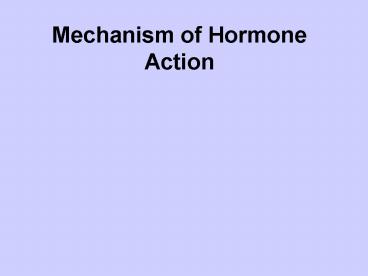Mechanism of Hormone Action - PowerPoint PPT Presentation
1 / 29
Title:
Mechanism of Hormone Action
Description:
( At physiological concentrations) ... change with physiological conditions: development, differentiation, stimulation or inhibition. ... – PowerPoint PPT presentation
Number of Views:1002
Avg rating:3.0/5.0
Title: Mechanism of Hormone Action
1
Mechanism of Hormone Action
2
Hormone Receptors
- All hormones act through receptors
- Cells that contain receptors are targets
3
Hormone Receptors
- Hormones regulate specific target tissues.
- How are target tissues selected by specific
hormones? - Determined through receptors on target cells that
provide the specificity for hormone-cell
interactions - Receptors may be located in the cell membrane,
cytoplasm, or nucleus.
4
Principles of Receptor Binding
- 1) Hormone specificity
- Receptors interact with (bind) specific hormones
- Hormones have a primary receptor, but may
interact with less affinity with other receptors.
Examples - Progesterone will bind androgen receptors
- Aldosterone will bind glucocorticoid receptors
- Testosterone will bind estrogen and progestin
receptors - 2) High affinity
- Receptor affinity is related to concentration of
hormone.
5
Principles of Receptor Binding
- 3) Tissue Specificity
- Target tissues containing receptors respond
specifically to the hormone (ligand) that binds
the receptor. (At physiological concentrations) - Some non-specific binding may occur to other
tissues, but this binding is of low affinity with
no hormonal or tissue specificity.
6
Principles of Receptor Binding
- 4) Saturable
- Usually one specific binding site per molecule
- Should be a finite number of receptors
- 5) Reversibility
- Hormone binding must be reversible.
- The on/off rate is dependent on binding
affinity
H R HR Effect
7
Number of Receptors
- Number of receptors is not static.
- Numbers change with physiological conditions
development, differentiation, stimulation or
inhibition.
8
Number of Receptors
- Hormones regulate their own or other hormone
receptors. - Prolactin induces appearance of prolactin
receptors (up regulation) - Prolactin induces appearance of estrogen
receptors (results in synergy) - Chronic exposure of cells to insulin results in
decreased binding (down regulation) of the
insulin receptor.
9
Number of Receptors
- Down regulation of receptors
10
Plasma Membrane Receptors
- Receptors bind water soluble hormones and
transduce the signal - Some membrane receptors are enzymes
- Some membrane receptors are coupled to G
(GTP-binding) proteins - Receptor Structure transmembrane protein
11
(No Transcript)
12
(No Transcript)
13
Plasma Membrane Receptors
- Spare receptors on the cell surface
- Usually more receptors on the plasma membrane
than needed for maximal response - Maximal biological responses is achieved when
only a small percentage of receptors are occupied
- Excess receptor number increases sensitivity of
the cell to low levels of hormone - Maximal stimulation of steroidogenesis by Leydig
cells occurs when only 1 of LH receptors are
occupied - Full steroid-induced transcriptional response may
only require 10 receptors
14
Plasma Membrane Receptors
- More than one hormone can activate the same
intracellular signal transduction - Example Several hormones can activate cAMP in
the same cell
15
Receptors that Activate G Proteins
- Rall Sutherland studied epinephrine (epi)
induced secretion of glucose from liver cells - Found ? in cAMP after epi treatment
- Identified adenylyl (adenylate) cyclase
- Orly Schramm demonstrated that epi receptor and
AC were separate molecules - Fused adrenal tumor cells (active AC) with turkey
RBC (functional receptor)
16
Synthesis and Breakdown of cAMP
17
Adenylyl Cyclase
18
Receptors that Activate G Proteins
- Rodbell Gilman et al. isolated and showed the
presence of a "Guanine nucleotide binding
protein" (a.k.a., G protein) that mediated the
effect of epi on AC
19
Role of G Proteins
20
Activation of Protein Kinase A
- cAMP activates Protein Kinase A (PKA)
- PKA phosphorylates various proteins in the cell
(ATP is PO4 donor) - PO4 put on OH groups of threonine serine of
proteins (changes their shape) - Phosphorylation can either activate or inactivate
proteins (bc of change in shape)
21
What Turns the cAMP System Off?
- G? protein has inherent GTPase activity
- Phosphodiesterase enzyme breaks down cAMP ? AMP
- Phosphatase enzymes remove PO4 groups from
proteins - Hormone/Receptor complex dissociates (or becomes
down-regulated )
22
Phosphatidylinositol/Phospholipase C System
23
Signal Transduction Leads to Cascade of Activity
- Proteins Regulated by Phosphorylation
- Kinases transfers PO4 onto proteins
- Enzymes regulate metabolism
- Transcription factors regulate gene activity
24
(No Transcript)
25
(No Transcript)
26
The Proteins Phosphorylated by PKA Depends on
Cell Type
- Different cell types contain different proteins
(enzymes) - Therefore, PKA activates different pathways in
different cells - Example
- PKA stimulates glycogen bkdn in liver
- PKA stimulates lipid bkdn in adipose tissue
27
(No Transcript)
28
Different signal molecules can initiate the same
response
- Example Epinephrine and glucagon both initiate
glycogen breakdown
29
(No Transcript)































